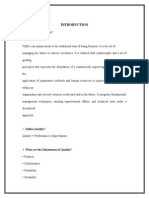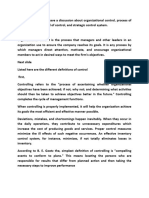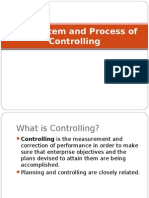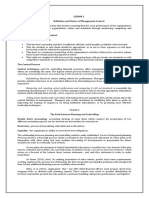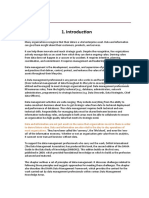0 ratings0% found this document useful (0 votes)
MGT Essay Test
MGT Essay Test
Uploaded by
Huy QuangThis document is an essay test response about management control. It discusses that control is a key function of management that compares actual performance to standards. There are four types of control purposes: adapting to change, limiting errors, coping with complexity, and reducing costs. The essay also outlines three types of control - areas of control, levels of control, and responsibility for control. Finally, it explains the four steps in the control process are establishing standards, measuring performance, comparing to standards, and considering corrective actions.
Copyright:
© All Rights Reserved
Available Formats
Download as DOCX, PDF, TXT or read online from Scribd
Download as docx, pdf, or txt
MGT Essay Test
MGT Essay Test
Uploaded by
Huy Quang0 ratings0% found this document useful (0 votes)
This document is an essay test response about management control. It discusses that control is a key function of management that compares actual performance to standards. There are four types of control purposes: adapting to change, limiting errors, coping with complexity, and reducing costs. The essay also outlines three types of control - areas of control, levels of control, and responsibility for control. Finally, it explains the four steps in the control process are establishing standards, measuring performance, comparing to standards, and considering corrective actions.
Original Title
Mgt Essay Test
Copyright
© © All Rights Reserved
Available Formats
DOCX, PDF, TXT or read online from Scribd
Share this document
Did you find this document useful?
Is this content inappropriate?
This document is an essay test response about management control. It discusses that control is a key function of management that compares actual performance to standards. There are four types of control purposes: adapting to change, limiting errors, coping with complexity, and reducing costs. The essay also outlines three types of control - areas of control, levels of control, and responsibility for control. Finally, it explains the four steps in the control process are establishing standards, measuring performance, comparing to standards, and considering corrective actions.
Copyright:
© All Rights Reserved
Available Formats
Download as DOCX, PDF, TXT or read online from Scribd
Download as docx, pdf, or txt
0 ratings0% found this document useful (0 votes)
MGT Essay Test
MGT Essay Test
Uploaded by
Huy QuangThis document is an essay test response about management control. It discusses that control is a key function of management that compares actual performance to standards. There are four types of control purposes: adapting to change, limiting errors, coping with complexity, and reducing costs. The essay also outlines three types of control - areas of control, levels of control, and responsibility for control. Finally, it explains the four steps in the control process are establishing standards, measuring performance, comparing to standards, and considering corrective actions.
Copyright:
© All Rights Reserved
Available Formats
Download as DOCX, PDF, TXT or read online from Scribd
Download as docx, pdf, or txt
You are on page 1/ 3
ESSAY TEST
Course: Introduction to Management - MGT103
Full Name : Nguyễn Trịnh Quang Huy
Student ID : SS160433
Class : MC1608
Instructor : Nguyễn Thị Thanh Nhàn
In an organization, control is a major goal-oriented function of management. It is a process of
comparing actual performance to the company's defined standards to ensure that actions are
carried out according to the plans, and if they aren't, corrective action is taken. It's critical to
grasp the many types of controls, the process and the purpose of the types of controls .
The function of controls is divided into four basic types of purposes: Adapting to
Environmental Change, Limiting Error Accumulation, Coping with Organizational
Complexity, and finally Reducing Costs. To begin, Adapting to Environmental Change:
There is no need for restrictions if a business sets goals and achieves them quickly. However,
in today's complex and dynamic business environment, all businesses must deal with change..
The process of achieving goals can be disrupted by events occurring both inside and outside
the business to achieve the aim, even if the goal is changed. As a result, a well-designed
control system can assist managers in anticipating, monitoring, and responding to changing
circumstances. Second, Limit Error Accumulation, small mistakes and omissions may not
have a significant impact on a company's financial health, they can add up over time and
constitute a significant financial burden. Third , Coping with Organizational Complexity :
When a company buys only raw materials, makes only one product, has a simple
organizational structure, and has steady demand for its product, management control occurs
in only one method. For a corporation that produces a variety of products, uses a variety of
materials, has a large market, a complex structure, and multiple competitors, a sophisticated
system is required to control all of the above. Finally , Mimimizing Costs : when it is
practiced effectively , control can also help reduce costs and boost output. Some
organizations have lowered everything from health insurance premiums to overnight delivery
to business lunches for customers in order to keep expenses down .
There are three types of control: Area of Control, Level of Control, and Responsibility for
Control . Firstly , Areas of Control might be centered on any part of the business. Physical,
human, information, and financial resources, inventory management, quality control, and
equipment control are the four basic categories of resources that most firms utilize to
construct control zones. Physical resources can be controlled in a variety of ways. Human
resource control includes employee selection and placement, training and development,
performance review, and compensation, among other things. Organizations also manage
employee behavior by encouraging them to attain high levels of performance at work and
avoid unethical behavior. Sales and marketing forecasting, environmental analysis, public
relations, production planning, and economic forecasting are all examples of controlling
information sources. Because it is linked to the management of all other resources in an
organization, financial resource management is the most significant area, including managing
the organization's financial obligations to ensure that they do not become excessive and that
the company always has enough cash to meet its obligations but no excess cash.
Secondly ,The methods used to transform an activity into an organization's product or service
are the focus of operations control . Financial control is concerned with the organization's
financial resources, with receipts being monitored to ensure that customers have paid their
bills on time. Structural control is the process of keeping track of administrative rates to
ensure that personnel costs do not grow excessive. Strategic control is concerned with the
effectiveness of corporate, corporate, and functional strategies in supporting the company in
attaining its goals. Finally , there's the Responsibility for Control, in which managers are in
charge of supervising the business's diverse control systems and issues, as well as selecting
which controls will be implemented. They carry out operations depending on data supplied
by the control system .
Each control process comprises four fundamental steps, regardless of the type or level of
control systems that an organization requires. The first step in the control process is
Establishing standard, a control standard that serves as a benchmark against which future
performance can be measured. Control standards should be expressed in words that can be
measured. The final step in the standard-setting process is to develop performance indicators,
which should be consistent with the organization's goals. The second phase is to assess
performance, which is something that businesses do on a regular basis. Employee
performance is frequently measured in terms of output quality or quantity. Sales performance
must be defined in terms of unit pricing, product quality, or product volume. The third step is
comparing performance against standards .The outcomes can be greater, lower, or the same
as the standard; however, if the performance is below the standard, it indicates that the
company's actions have deviated significantly from the initial standard and that corrective
action is required. repair, and vice versa A number of factors, including the relevance and
complexity of controls, influence how long it takes to compare performance to the standard.
And the final step is Considering Corrective Action. Decisions for corrective action are
primarily reliant on management's analytical and diagnostic ability. After comparing
performance to control standards, you have three choices: keep things as they are, correct the
difference, or modify the standard. When performance meets state standards, maintaining the
status quo is prioritized. Changing an established standard usually is necessary if it was set
too low or too high at the outset.
In conclusion , the control function serves four primary objectives: Adapting to
Environmental Change, Limit the accummulation of error , Coping with Organizational
Complexity, and Minimize Costs. Three types of control exist: area of control, level of
control, and responsibility for control. Establishing Standards, Measure Performance,
Compare Performance to Standards, and Considering Corrective Action are the four
processes in the control process.
You might also like
- Controlling System in Engineering Management100% (2)Controlling System in Engineering Management30 pages
- Riskwork Essays On The Organizational Life of Risk ManagementNo ratings yetRiskwork Essays On The Organizational Life of Risk Management322 pages
- Controlling Function of Management - Admin Process in NSGNo ratings yetControlling Function of Management - Admin Process in NSG13 pages
- Control Over Policies: The Need of Control Over Policies Is Self-Evident. in Many Enterprises, TheNo ratings yetControl Over Policies: The Need of Control Over Policies Is Self-Evident. in Many Enterprises, The9 pages
- 1. QTHTA_C7_CD7.1_ Organizational control and Control processNo ratings yet1. QTHTA_C7_CD7.1_ Organizational control and Control process4 pages
- 2. QTHTA_C7_CD7.2_Type of control and control systemNo ratings yet2. QTHTA_C7_CD7.2_Type of control and control system4 pages
- Engineering Management: University of Eastern Philippines Laoang CampusNo ratings yetEngineering Management: University of Eastern Philippines Laoang Campus11 pages
- Organization For Administration and ControlNo ratings yetOrganization For Administration and Control3 pages
- TASK PERFORMANCE-Strategic Cost Acctg-PrelimNo ratings yetTASK PERFORMANCE-Strategic Cost Acctg-Prelim5 pages
- Explain The Characteristics of An Effective Control SystemNo ratings yetExplain The Characteristics of An Effective Control System3 pages
- Principles of Management The System and Process of Controlling GTU MBA0% (1)Principles of Management The System and Process of Controlling GTU MBA20 pages
- Control (Management) : Navigation SearchNo ratings yetControl (Management) : Navigation Search4 pages
- Reviews in Different Controlling Mechanics: Types of Control MechanismsNo ratings yetReviews in Different Controlling Mechanics: Types of Control Mechanisms26 pages
- Ge 404-Lecture-1course Description and Introduction 1 0No ratings yetGe 404-Lecture-1course Description and Introduction 1 029 pages
- Clinical Performance Development and Management SystemNo ratings yetClinical Performance Development and Management System26 pages
- Student Guide BSBMKG413 Promote Products and ServicesNo ratings yetStudent Guide BSBMKG413 Promote Products and Services26 pages
- Class - 12th Business Studies Nature and Significance of ManagementNo ratings yetClass - 12th Business Studies Nature and Significance of Management68 pages
- Lecture-6: Organization Structure, Coordination and Spans of Control, Managing Organizational Change and ConflictNo ratings yetLecture-6: Organization Structure, Coordination and Spans of Control, Managing Organizational Change and Conflict53 pages
- Ciadmin, Journal Manager, 7498-29919-1-CENo ratings yetCiadmin, Journal Manager, 7498-29919-1-CE6 pages
- Definition of Terms: Presented By: Shyndie C. LasolaNo ratings yetDefinition of Terms: Presented By: Shyndie C. Lasola20 pages
- (Havinal Veerabhadrappa) Management and Entreprene (BookFi)No ratings yet(Havinal Veerabhadrappa) Management and Entreprene (BookFi)195 pages
- Talent Management - Competency Development: Key To Global LeadershipNo ratings yetTalent Management - Competency Development: Key To Global Leadership15 pages
- CBB FOR PROFIT AND NOT FOR PROFIT ORGANISATION50% (2)CBB FOR PROFIT AND NOT FOR PROFIT ORGANISATION7 pages
